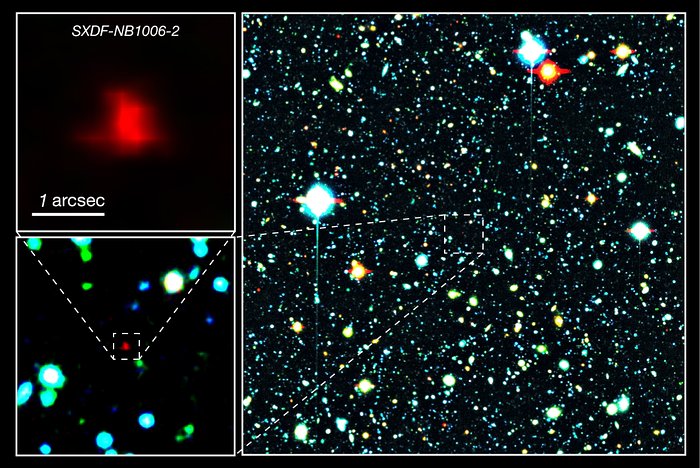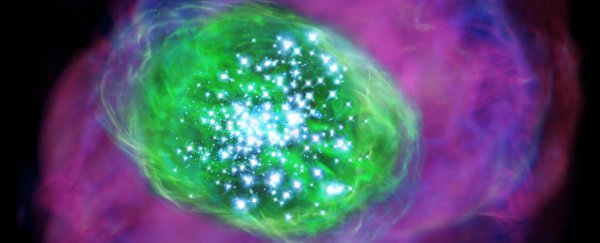Scientists have detected the presence of oxygen in a distant galaxy some 13.1 billion light-years from Earth. That's so far away, what we're seeing is the galaxy as it was when the Universe was still very young, just 700 million years after the Big Bang.
The discovery is the most distant clear signal of oxygen in the Universe that scientists have ever detected, and it could help us understand more about a phase in the early Universe called cosmic reionisation.
Back when the Universe was very young, at about 400,000 years old, scientists think the gas in it existed in a neutral state – that is, until the first giant stars formed, and began ionising hydrogen gas with their radiation.
This cosmic reionisation process took place over about a billion years, but scientists still don't fully understand the stellar phenomena that made it happen.
If we can find out more about the chemical composition of these ultra-distant, early-Universe galaxies – particularly what heavy elements they contained, we might finally have the clues we need to piece together the early Universe. And that means tracking down any element other than hydrogen or helium.
"Seeking heavy elements in the early Universe is an essential approach to explore the star formation activity in that period," said lead researcher Akio Inoue from Osaka Sangyo University in Japan. "Studying heavy elements also gives us a hint to understand how the galaxies were formed and what caused the cosmic reionisation."
The astronomers made the discovery using the Atacama Large Millimeter/submillimeter Array (ALMA) in Chile. The galaxy in question, called SXDF-NB1006–2, was discovered by scientists in 2012, and at the time was the most distant galaxy we had ever found. Today, the most distant galaxy we know about is the more recently discovered GN-z11.
Before observing oxygen in SXDF-NB1006–2, the team ran simulations to gauge how accurately ALMA would be able to detect the element. Their direct observations with ALMA confirmed the results, suggesting firm evidence that oxygen existed in the early Universe.
But while oxygen was present, it was found in very small amounts, being 10 times less abundant than it is in the Sun.
"The small abundance is expected because the Universe was still young and had a short history of star formation at that time," said astrophysicist Naoki Yoshida from the University of Tokyo. "Our simulation actually predicted an abundance 10 times smaller than the Sun. But we have another, unexpected, result: a very small amount of dust."
The scientists think this relative lack of dust in SXDF-NB1006–2 – which would be made up of heavy elements – could mean that most of the gas in the galaxy is already ionised. It would also make it easier for light from the young galaxy's stars to extend outwards and ionise gas in other galaxies.
 The red galaxy at the centre of the main image is the distant galaxy, SXDF-NB1006-2. On the left, some close-ups. Credit: NAOJ
The red galaxy at the centre of the main image is the distant galaxy, SXDF-NB1006-2. On the left, some close-ups. Credit: NAOJ
"SXDF-NB1006–2 would be a prototype of the light sources responsible for the cosmic reionisation," said Inoue.
The researchers intend to keep ALMA focused on SXDF-NB1006–2 to see what else we can find out about stellar processes occurring within it. After all, while we now know oxygen played a part in SXDF-NB1006–2 early on, there's still an awful lot we don't understand about cosmic reionisation, and this galaxy provides an excellent opportunity to discover more.
"This is an important step towards understanding what kind of objects caused cosmic reionisation," said one of the team, Yoichi Tamura from the University of Tokyo. "Higher-resolution observations will allow us to see the distribution and motion of ionised oxygen in the galaxy and provide vital information to help us understand the properties of the galaxy."
The findings are reported in Science.
